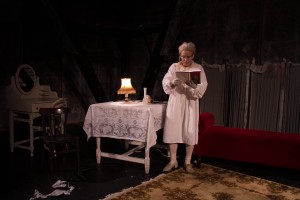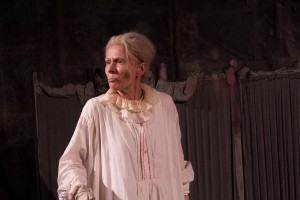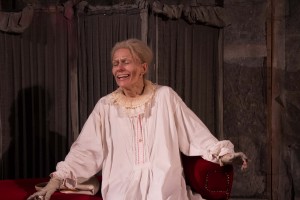About This Clip
Poor Poor Lear
BITOLA SHAKESPEARE FESTIVAL 2013
POOR POOR LEAR is a one-woman show by Finnish writer-performer Nina Sallinen. She portrays an elderly actress doing a farewell performance, a solo production of King Lear, in her small apartment.
Created by Nina Sallinen and Katja Krohn
Performed by Nina Sallinen
Review by Randall Martin
The audience was waiting to get into the basement playing space of the National Theatre. Behind the door an old woman’s voice screamed “Go away!” The door opened. “Oh, welcome my friends!” The 90-year Nina Sallinen appeared in faded white shoes and stockings, a long 1960s coat, yellowed lace collars, stained white leather gloves, and wild hair. Excitedly she escorted us into “the unfair, cruel, sad, story of poor King Lear!”, as it said on the hand-scrawled programme notes she handed out.
A few pieces of lace-covered of furniture are scattered across her small spare flat, including a dining table with bread cut, a toaster, and burn marks above it on the wall. Several b&w stage photos of the famous actor hang around the room. There are also two front–row chairs with the names of Nina’s daughters posted on the back. Because this performance is for them.
In this tragi-comic tour de force, Nina Sallinen journeys through a highly subjective, hugely entertaining, and increasingly confessional version of King Lear. Her performance is meant to be a guilt-trip for her two daughters, to whom she recently signed over her flat to avoid death-duties. Now they and their husbands are trying to get her into a nursing home after a fiery incident with the toaster. A bitter offstage phone call with a one daughter and a screaming match with a bewildered man sent to move her furniture makes it clear Nina isn’t leaving before she gets revenge – with us as sympathetic witnesses. After tearing up the names on the two chairs, an old felt hat becomes Regan, a doll Goneril, and a white rose Cordelia, followed by self-justifying visits to her heartless daughters. A blaring hair-dryer becomes her storm. Nina’s rage against filial ingratitude breaks off just before Shakespeare’s Lear recognizes the humanity of his fellow sufferers. She offers us Turkish delight and lemonade – really! — and then goes off to rest.
It’s difficult to do justice to Sallinen’s mesmerizing, hilarious, and moving performance. Her voice roars, cracks, sobs, howls, and shamelessly importunes. Her tottering bustle, cackling energy, and costly little outbursts of physical exertion – as when she gives the suitcase for visits to her daughters a swift kick, or strains up or down from her sofa — are riveting. Perhaps the greatest success of her show is the skill with which she walks a fine line between the moving pathos of a lonely old woman trapped by memories of former glamour, and maudlin self-pity. Sallinen balances Nina’s vanity and vulnerability flawlessly.
Nina returns to admit her dramatic ruse has failed. Now more relaxed in a vintage nightgown (with a large ironing burn on the back), she tries to salvage the evening by reading Lear’s awakening reunion with Cordelia, where, in her view, Lear’s admission of wrong deserves and receives unconditional forgiveness. But lacking a third daughter, she sits on the sofa and slowly lays bare her guilt at sacrificing the full-time care of her children for her stage career. In perhaps the most beautiful line of the play, she confesses she needed recognition of the “world of possibilities in my self.” She invites us to become the petals of her white rose by tapering off into silence and searching the eyes of spectators for a good 30 seconds. Suddenly reverting to her old ego, her project seems to fail. But in a final show of Sallinen’s dizzying intermingling of stage illusion and theatrical reality, our standing ovation appears to give her the redemption Nina craves.
Poor Poor Lear
Clips
Essays
Review of Poor Poor Lear from the 2013 Bitola Shakespeare Festival
The audience was waiting to get into the basement playing space of the National Theatre. Behind the door an old woman’s voice screamed “Go away!” The door opened. “Oh, welcome my friends!” The 90-year Nina Sallinen appeared in faded white shoes and stockings, a long 1960s coat, yellowed lace collars, stained white leather gloves, and wild hair. Excitedly she escorted us into “the unfair, cruel, sad, story of poor King Lear!”, as it said on the hand-scrawled programme notes she handed out.more
The audience was waiting to get into the basement playing space of the National Theatre. Behind the door an old woman’s voice screamed “Go away!” The door opened. “Oh, welcome my friends!” The 90-year Nina Sallinen appeared in faded white shoes and stockings, a long 1960s coat, yellowed lace collars, stained white leather gloves, and wild hair. Excitedly she escorted us into “the unfair, cruel, sad, story of poor King Lear!”, as it said on the hand-scrawled programme notes she handed out.
A few pieces of lace-covered of furniture are scattered across her small spare flat, including a dining table with bread cut, a toaster, and burn marks above it on the wall. Several b&w stage photos of the famous actor hang around the room. There are also two front–row chairs with the names of Nina’s daughters posted on the back. Because this performance is for them.
In this tragi-comic tour de force, Nina Sallinen journeys through a highly subjective, hugely entertaining, and increasingly confessional version of King Lear. Her performance is meant to be a guilt-trip for her two daughters, to whom she recently signed over her flat to avoid death-duties. Now they and their husbands are trying to get her into a nursing home after a fiery incident with the toaster. A bitter offstage phone call with a one daughter and a screaming match with a bewildered man sent to move her furniture makes it clear Nina isn’t leaving before she gets revenge – with us as sympathetic witnesses. After tearing up the names on the two chairs, an old felt hat becomes Regan, a doll Goneril, and a white rose Cordelia, followed by self-justifying visits to her heartless daughters. A blaring hair-dryer becomes her storm. Nina’s rage against filial ingratitude breaks off just before Shakespeare’s Lear recognizes the humanity of his fellow sufferers. She offers us Turkish delight and lemonade – really! — and then goes off to rest.
It’s difficult to do justice to Sallinen’s mesmerizing, hilarious, and moving performance. Her voice roars, cracks, sobs, howls, and shamelessly importunes. Her tottering bustle, cackling energy, and costly little outbursts of physical exertion – as when she gives the suitcase for visits to her daughters a swift kick, or strains up or down from her sofa — are riveting. Perhaps the greatest success of her show is the skill with which she walks a fine line between the moving pathos of a lonely old woman trapped by memories of former glamour, and maudlin self-pity. Sallinen balances Nina’s vanity and vulnerability flawlessly.
Nina returns to admit her dramatic ruse has failed. Now more relaxed in a vintage nightgown (with a large ironing burn on the back), she tries to salvage the evening by reading Lear’s awakening reunion with Cordelia, where, in her view, Lear’s admission of wrong deserves and receives unconditional forgiveness. But lacking a third daughter, she sits on the sofa and slowly lays bare her guilt at sacrificing the full-time care of her children for her stage career. In perhaps the most beautiful line of the play, she confesses she needed recognition of the “world of possibilities in my self.” She invites us to become the petals of her white rose by tapering off into silence and searching the eyes of spectators for a good 30 seconds. Suddenly reverting to her old ego, her project seems to fail. But in a final show of Sallinen’s dizzying intermingling of stage illusion and theatrical reality, our standing ovation appears to give her the redemption Nina craves.
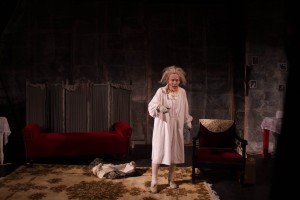
Nina Sallinen’s Poor Poor Lear
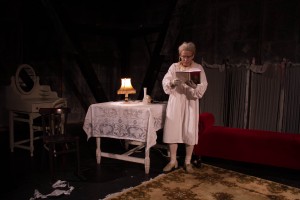
Nina Sallinen’s Poor Poor Lear
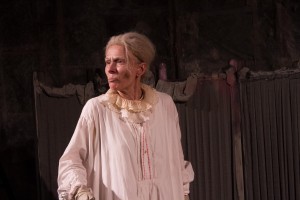
Nina Sallinen’s Poor Poor Lear
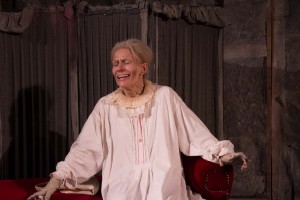
Nina Sallinen’s Poor Poor Lear
Randall Martin is Professor of English at the University of New Brunswick. His books include Henry VI Part Three (ed. 2001), Women, Murder, and Equity in Early Modern England (2008), Shakespeare / Adaptation / Modern Drama (co-ed. with Katherine Scheil, 2011) and Shakespeare and Ecology (2015).
Sallinen, Nina | Productions
Related Productions
- El rey Lear (King Lear) (Reyes, Marcos; 1967)
- Kral Lear (King Lear) (Coleman, Basil; 1981)
- Kral “Soyatrım” Lear (“My Fool” King Lear) (Sertdemir, Yiğit; 2014)
- Kraliçe Lear (Queen Lear) (Esmer, Pelin; 2019)
- Samrat Lear (King Lear) (Brown, John Russell; 1997)




